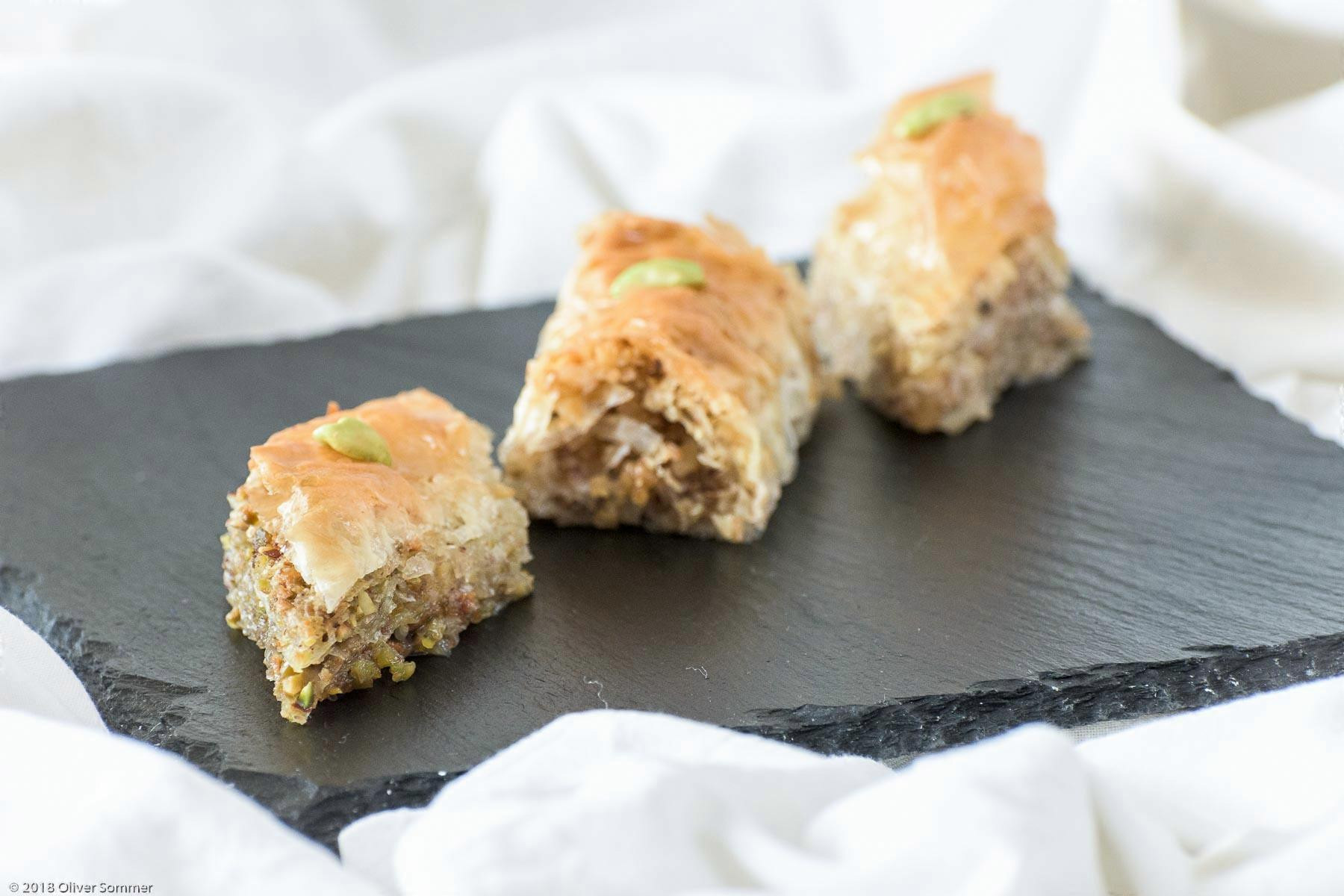Baklava is the most typical, most famous Turkish dessert. It is made from many thin layers of Yufka (Filo in Greek). The tasty secret lies in the balance of butter, sugar syrup and the nuts used (mostly walnuts, but you can also use hazelnuts or pistachios). The preparation of filo pastry at home is very difficult. The individual dough sheets are rolled out so thinly that you can put a newspaper underneath and read it. That’s why I will stick to a recipe using Yufka from the store.
A little bit of history
The word Baklava is Turkish and is related to the Mongolian term for “winding”. This sweet pastry was already enjoyed in the 17th century, in Topkapı palace in Istanbul. Every year for Eid al-Fitr (end of Ramadan), the Janissaries (the elite group of the Ottoman army) received countless trays with freshly prepared Baklava from the Sultan as a sign of his appreciation. If the soldiers were satisfied with their salaries and the government, they gratefully accepted this gift. Otherwise the trays went back to court untouched. Only master chefs were hired in the Saray for the production of Baklava. In addition to a good “pilav” (Pilaf in English, a dish that is usually made from rice or bulgur), the chefs also had to bake Baklava to prove their kitchen skills.
Tatlı yiyelim, tatlı konuşalım
Sweet let’s eat, sweet let’s talk – Turkish saying
This saying is particularly true when a guy takes a package of Baklava to the house of his future bride to ask her to marry him. Even Sultans did so to charm their harem ladies. It is customary to share Baklava among friends and neighbors on joyful occasions such as weddings, births or religious festivities.

How-to tip: If you cut baklava with a fork, you will hear an appetizing crunch and smell the butter. This is how you recognize good Baklava. The roasted nuts, butter and syrup become a real treat for your taste buds.
Ingredients
- 500 g filo pastry sheets (about 15-20 sheets)
- 250 g butter
- 350 g walnuts (alternatively, pistachios and hazelnuts are popular, and cashew nuts make an extraordinary Baklava)
- 500 ml rose syrup or orange blossom syrup, or more to taste
Or alternatively turn the following into a syrup:
- 300 ml water
- 200 g sugar
- 1 tbsp lemon juice, freshly squeezed
- 20 ml of rose water or orange blossom water

Preparation
Finely chop the walnuts. Melt the butter. If necessary, prepare the sugar syrup: In a saucepan, mix the sugar with water, bring to a boil, let it dissolve and simmer for 5 to 10 minutes over low heat. Stir in lemon juice and rose water.
Burma baklava – sweet filo pastry rolls
Prepare a long, thin rolling pin (simple wooden stick with 2 cm diameter from the hardware store). Open the filo packaging, lay out the sheets on the countertop. Don’t take any breaks now, as the filo dough dries out very quickly. We will roll up along the long side. Using a basting brush, butter the top sheet of the pile. Spread walnuts on top. Do not take too much. If you use too much of the walnuts, the dough may break. Roll up the sheet on the rolling pin. Leave the rolling pin until the next sheet is ready to roll up. Butter the second sheet and roll it up with the first one inside. No walnuts go on the second sheet!

Then carefully and lightly squeeze the dough together from the ends of the rolling pin and push it off the rolling pin onto the oven pan. If the dough is already dry and brittle, it helps to coat the roll with some butter from the outside. If the dough roll turned out shorter than the available space, carefully pull the dough roll apart so that it fits exactly into the oven pan. Repeat these steps until the sheets are used up.
Pour the remaining butter over the prepared Baklava. Preheat the oven and bake at 180 degrees about 35 – 40 min. The Baklava is ready when it turns light brown on top. Immediately cut the hot Baklava with a very sharp knife. Each dough roll should be cut into about 6 pieces. Pour the hot syrup over the Baklava while it’s still warm. Allow it to cool and sit for a while.

Cevizli Baklava – sweet filo pastry cuts
Grease the bottom of an ovenproof pan (about 25×35 cm) with a little butter. First lay out two layers of filo sheets (so that the entire bottom is covered with a double layer of filo) and butter the top one. If you have a basting brush, use it! Loosely place a third sheet on top, it should be slightly wrinkled (so that the Baklava is nice and fluffy later) and should cover the side of the pan. Butter and then evenly sprinkle some of the chopped walnuts on top. Keep alternating until the filo pastry sheets and chopped walnuts are used up. Carefully layer the last two sheets in the pan.
Prior to baking, slice the layered baklava into square or diamond shaped pieces of equal size using a very sharp knife. Mark straight lines with a large knife, then, carefully cut through the bits with a smaller sharp knife.

Cover the Baklava evenly with the remaining butter. Sprinkle the Baklava with a little cold water so that the dough doesn’t rise and the surface becomes crispy. Bake the Baklava at 160 degrees for about 30 to 40 minutes until golden brown.
After baking, pour the hot syrup over the baklava while it’s still warm. Allow it to cool and sit for a while. Renew the previous cuts with a knife.


